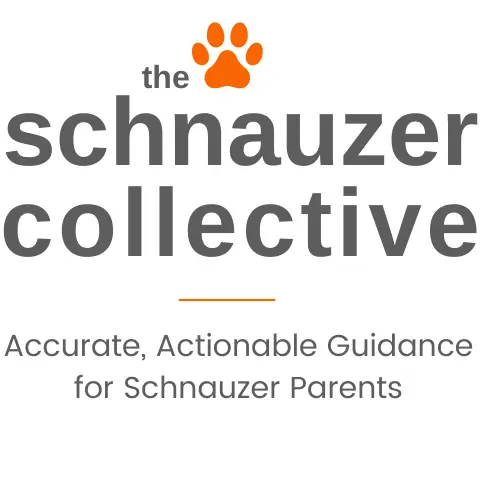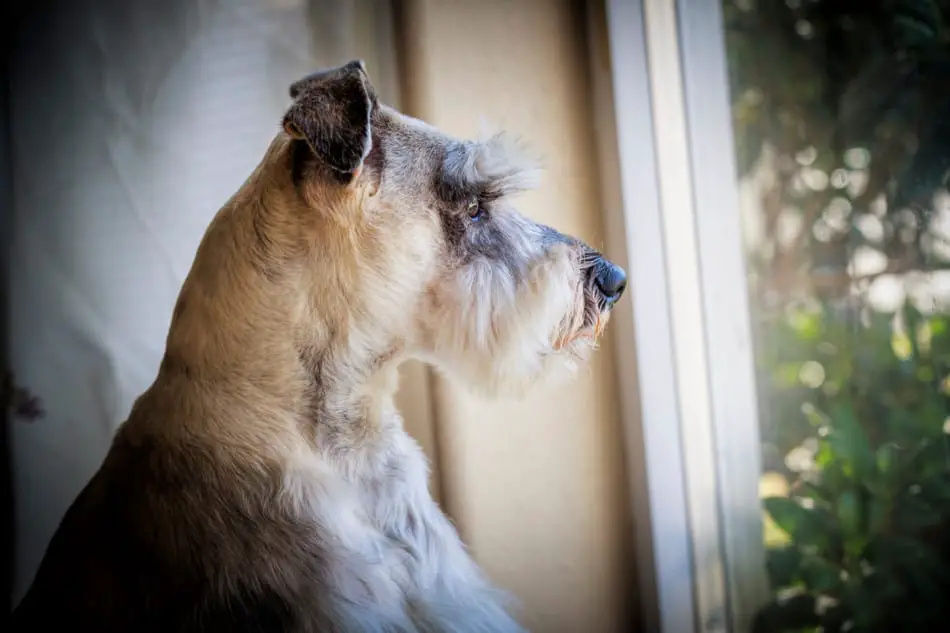Every time Livi sniffs obsessively on her walking trail, or her ears perk up at something I can’t even hear, I’m intrigued by how differently she and I might perceive the world around us. It’s hard enough to truly put yourself in another person’s shoes, but trying view the world through the lens of an entirely different species seems almost insurmountable. However, I wanted to understand more about our Schnauzer’s senses and decided to look into the research.
What are Schnauzer senses like? A Schnauzer’s sense of smell is exceptionally superior to humans by thousands of percent, and they can hear frequencies that are two times higher than we can and at four times the distance. Their sight is limited to yellows, blues, and grays. Their sight is also blurry and nearsighted, but able to detect far away movement. They can detect bitter, sour, sweet, and salty flavors, but only have a fraction of the taste buds.
It’s easy to take our own senses for granted, and to assume that other species, including Schnauzers, experience the world in the same way we do. Canine research continues to evolve and develop in ways that help us to understand man’s best friend and how she or he experiences and interprets the world we share.
Studying the senses of our Schnauzers, as well as other lifeforms on this planet, gives us a fascinating glimpse into how much we all still have to learn.
THE SCHNAUZER COLLECTIVE
Here is our basic understanding of how Schnauzers sense the world.
What Can Dogs See Compared to Humans?
Schnauzers are said to be color blind and it is partially true. It is currently believed that dogs can see essentially the same color spectrum as humans who experience red-blue color blindness. As with humans whose red-blue receptors are defective (and the eyes cannot perceive those two colors), Schnauzers see only blues, yellows, and grays. Rather than having defective cones, Schnauzers are simply limited to two types of cones, as opposed to having the three receptor cones humans are born with.
However, your Schnauzer can see better at night and in low, dim light overall. This is because their retinas have more rod cells for differentiating shades of gray (not color) that we cannot even detect. In addition, their larger pupils allow more light for better low-light vision. But, by far, a Schnauzer’s best advantage for nighttime and low-light vision is their tapetum. The tapetum is located at the back of the eye and is a mirror-like structure that reflects light which gives their retina an additional chance to register and process light, increasing their perception. The tapetum is also what makes your Schnauzer’s eyes “glow” at night.
Schnauzers are near-sighted overall compared to human beings. Their visual sharpness as compared to that of ours is 20/75, which quite blurry. Unlike humans who can see objects 75 feet away, dogs cannot see objects past 20 feet, generally speaking. Schnauzers do have a wider field of vision, however, and can also, even though they are near-sighted, can detect faraway movement better than we can. You actually have the option to use contact lenses to correct near-sightedness, particularly if your Schnauzer is playing a specific role such as a service dog.
What Can Dogs Hear Compared to Humans?
As you may know, your Schnauzer’s hearing is far better yours. She can hear sounds that are four times farther away, and can also hear very high frequencies ranging from about 67-45,000 Hz, such as the pitch of the dog’s whistle. The frequency that we can detect is much lower, ranging from about 64-23,000 Hz.
In addition, Schnauzer ears have about 18 muscles, while human being’s ears have only six muscles. This high number of muscles enables them to rotate their ears much more precisely towards the direction of any sound. It’s also believed that Schnauzers with cropped or perked ears have better hearing than those whose ears have been left uncropped and floppy. Whether or not this is actually true is still debated.
A Schnauzer’s inner ear canal is also quite long and is capable of being rotated by the 18 muscles to a position where it can accurately capture a faraway sound. Additionally, even the shape of Schnauzer ears is believed to amplify sound.
How Well Can Dogs Smell Compared to Humans?
The sense of smell in dogs is 10,000 to 100,000 times stronger than that of human beings. Schnauzers use their incredible sense of smell to interpret the world.
Your Schnauzer’s nose has up to 300 million olfactory receptors that enable her sense the world and to carry out a range of tasks. It is this large number of receptors that heightens a dog’s ability to smell by 10,000-100, 000 times better than humans. Also, the area of the brain that interprets odors is 40 times larger than ours.
Due to this incredible sense of smell, police dogs are easily trained to detect illegal drugs, explosives, and other illegal substances. They also use the same sense of smell to identify a prey when hunting, and can identify many diseases by merely sniffing the patient. Pheromones secreted by the apocrine glands give your Schnauzer a wide range of information about human beings and other mammals.
Schnauzer’s noses are not only used for breathing, they also drain excessive tears from their eyes. Incredibly, their noses also contain sweat glands that regulate body temperature.
Schnauzer noses also have a unique construction that enables them to breathe in and out at the same time (what?), as well to as facilitate respiration. Once breathed in, the air follows a side route and enters the olfactory recess that contains olfactory receptor genes and receptor cells that absorb odors.
How Well Can Dogs Taste Compared to Humans?
Just like humans, dogs can taste bitter, sour, sweet, and salty flavors. However, the Schnauzer sense of taste is very inferior since they have only 1,706 taste buds as compared to 9,000 taste buds in humans. The taste buds appear on the tip of the dog’s tongue and licking their noses is one way they connect their sense of taste and smell.
Despite having a small number of taste buds, canines often prefer meat to a diet with no meat simply based on the smell. However, they cannot tell the difference between beef, pork, fish, or chicken without smelling the meat first. The strong sense of smell in dogs compensates for their weak sense of taste. In fact, Schnauzers (and all dogs) have a special organ along their palate that enables them to detect different flavors using their sense of smell.
Sense Differences in Puppies, Adults, and Seniors
Sense Differences in Puppies and Adult Dogs

| Seeing | A puppy’s eyes are closed at birth, but generally open in 10 to 16 days. Just like adults, puppies, too, see a limited number of colors, which are blue, yellow, gray, and white. They see better in the dark or dim light, and they can track moving objects better than stationary ones. Puppies who are three weeks old can easily track fast-moving objects. The sharpness of their vision develops as they gets older. |
| Hearing | Puppies are born deaf and cannot hear anything until they are at least three weeks old. Just like adult dogs, puppies can listen to very high frequencies and four times of what human beings hear. The frequency range for both puppies and adult dogs is almost the same, ranging from about 60 to 60,000 Hz. |
| Smelling | Dogs have an incredible sense of smell from birth. It is this sense that puppies use to navigate and locate their mother, siblings, and milk before their eyes open. Their sense of smell gets stronger as puppy matures. |
| Tasting | Both adult Schnauzers and puppies have about 1700 taste buds. They can taste the four main categories of flavors, which are sweet, sour, salty, and bitter. |
Sense Changes in Older Dogs

| Vision | As Schnauzers get older, their vision starts to decline. This problem arises due to thickening lenses or changes in the retina. Schnauzers are also prone to cataracts and other eye issues. |
| Hearing | This sense, too, decreases as the dog gets older. A change in the external hearing mechanisms causes hearing to decline, and she could become completely deaf if the underlying cause is not treated. Work with your veterinarian if you notice your Schnauzer is becoming much less responsive to commands and seems to be losing her hearing. |
| Tasting and smelling | These, too, are likely to decline as the dog ages. Signs of changes in your Schnauzer’s sense of taste include a loss of appetite and an alteration in food preferences. Her sense of smell can possibly compensate for any loss of hearing or sight. As mentioned above, dogs use their sense of smell to interpret the world. |
We live in a complex ecosystem full of life. We are also surrounded by light, sound, and pressure frequencies we cannot even perceive. Advances in technology have confirmed a much wider spectrum of light, sound, and pressure that surrounds us, and the technology helps us to understand the world more fully. However, Schnauzers, along with other animals, are more naturally able to perceive these realities. Studying the senses of our pups as well as other lifeforms on this planet gives us a fascinating glimpse into how much we all still have to learn.
And finally, from one pet parent to another, discover my all-time favorite resources designed to cover your every Schnauzer need. I’ve done the legwork for you so you can spend more time with the people and fur friends in your life.
A portion of all profit earned on this site is donated to Pet Partners
whose mission is to improve human health and
well-being through the human-animal bond.
They train and register pets to become therapy animals,
and have local chapters in many states.

